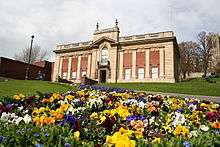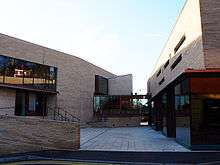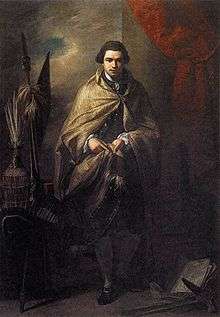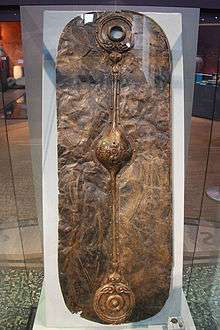The Collection (Lincolnshire)



The Collection is the county museum and gallery for Lincolnshire in England. It is an amalgamation of the Usher Gallery and the City and County Museum in such a way that they can work more effectively together than hitherto. The museum part of the enterprise is housed in a new, purpose-built building close by the Usher Gallery in the city of Lincoln.
The site
Lincoln consists of two parts, that at the top of the cliff and that in the Witham valley. The site of the collection is on the steep slope between the two and within the Roman colonia which linked the first century legionary fortress with the shipping and commerce in the river. The new building presents its qualities modestly so as to enhance its surroundings which, towards the end of the twentieth century had slightly developed the feeling of a no man's land.
- Aerial view of the site. The Usher Gallery is visible in its gardens while the museum, on the western side of Danesgate, is the building to its south-west, rectangular in plan and with the complex roof pattern.
The buildings
The Usher Gallery was built to house the collection of James Ward Usher, using funds he bequeathed for the purpose. It was designed by the architect, Sir Reginald Blomfield and was officially opened on 25 May 1927 by the Prince of Wales. It is a basically simple building faced in stone with brick panels separated by simplified Tuscan pilasters above which is a frieze decorated with triglyphs and a roof line finished with a balustrade. The portico, central in the south façade, is topped by a broken pediment and urn finials. It stands in a small park on the hillside looking southwards across the lower town.[1]
The Usher Gallery is a Grade II* Listed Building.[2][3]
Following an architectural design competition managed by RIBA Competitions Panter Hudspith Architects (project architect, Hugh Strange) designed the new building and the doors were opened in October 2005 after much hard work including an archaeological excavation. Despite the building's having been designed to rest above the Roman horizon, at the foot of the pit for the lift shaft, it just found the corner of a mosaic-paved passage which had been laid around a courtyard.[4]
Much of the new building is faced and paved with Ancaster stone and borrows the concept of the glass-covered courtyard from the British Museum in a feature reminiscent of a medieval alley. The various requirements of the building, permanent display, temporary exhibitions, teaching, café and so on, are represented by corresponding elements of the building which give it, internally and externally, the feeling of an urban community, though the whole forms a distinctive unit in the townscape.
The main entrance is at the northern, uphill end and leads past, to the left, the café which faces south across a sculpturally interesting courtyard and to the right, the shop. Passing the reception desk leads to the orientation hall which is the glass-covered 'alley' passing east to west. From it, the visitor reaches auditorium where video or personal introductions to the museum or to education courses may be given; the education suite; the archaeological collection or the New Curtois Gallery, where touring exhibitions are housed. Below these last two, at the downhill end of the building, are the stores and workshops which service the whole.[5]
The exhibits


The sample of mosaic, exposed by the pre-construction archaeological excavation is now on view inside as part of a display extending through all periods from the Ice age. The mosaic is the largest to be discovered in Lincoln for over a hundred years[6]
The archaeological exhibition in The Collection building is organised as a timeline from the stone age, through Roman and Viking occupation to the Medieval.[7] Much of the Iron Age material is from the dig at Fiskerton, including the Fiskerton Boat.[8] It includes a satellite photograph of the county of Lincolnshire on a scale which permits fields and villages to be sought out while the picture's extent allows a general pattern of geology and the influence of the Roman roads to show through.
The long-established displays in the Usher Gallery include furniture, clocks and other forms of the decorative arts, from Usher's collection. There is a range of fine art works by J. M. W. Turner, John Piper and L. S. Lowry. The gallery's specialism is in the works of Peter De Wint, a former Lincoln resident. Four galleries of various sizes are set aside for temporary exhibitions.
Modern and Contemporary Art programme
The Usher Gallery has an established programme of inviting contemporary curators and artists to exhibit modern and contemporary artwork in the main galleries alongside the Usher collection. In 2014, print works by Andy Warhol, Pablo Picasso, Salvador Dali and Henri Matisse from the touring show Modern Masters went on display at the Museum.[9] In 2013, conceptual artist and academic, Professor Raimi Gbadamosi was invited to curate the rehang display What's Going On, featuring loans from The Arts Council Collection, The British Art Medal Society and contemporary artists, Edward Allington, Kimathi Donkor, Amanda Francis, Permindar Kaur, Taslim Martin, Janette Parris, Ritu Sood, Susan Stockwell, Maiko Tsutsumi & Mark Woods[10][11]
Gulbenkian Prize
In May 2006, The Collection was on a short list of four innovative museums being considered for the 2006 Gulbenkian Prize. The prize was awarded to SS Great Britain.[12]
References
- ↑ "James Ward Usher". Famous Yellowbellies. BBC Lincolnshire.
- ↑ Historic England. "The Usher Art Gallery (Grade II*) (1388632)". National Heritage List for England.
- ↑ Historic England. "Wall and gatepiers (Grade II) (1388634)". National Heritage List for England.
- ↑ "The Collection, Lincoln". Case studies...Museums and galleries. RIBA. 2009. Retrieved 8 July 2013.
- ↑ "The Collection". case studies. Commission for Architecture and the Built Environment. Archived from the original on 18 January 2011. Retrieved 1 January 2011.
- ↑ Prudames, David (15 July 2003). "2000-Year-Old Mosaic Unearthed Under New Museum In Lincoln". Culture24. Department of Education. Retrieved 8 July 2013.
- ↑ "Highlights of the Collection". Lincs to the past. Lincolnshire county council. 2012. Retrieved 8 July 2013.
- ↑ Kennedy, Anra (26 March 2002). "Treasures Of The Celtic Causeway - The Fiskerton Log Boat". Culture24. Department for Education. Retrieved 8 July 2013.
- ↑ "BBC News". Modern Masters exhibition opens in Lincoln's Usher Gallery. The BBC. 2014. Retrieved 8 August 2015.
- ↑ "Artists Talks at The Collection". The Collection. The Collection. 2013. Retrieved 8 August 2015.
- ↑ Carty, Ella (2013). "Permindar Kaur to show work at the Usher Gallery in Lincoln". Digswellarts.org. Digswell Arts. Retrieved 8 August 2015.
- ↑ The Gulbenkian Prize
External links
- The Collection - official site
- The Collection - Lincolnshire County Council website
- Brief for the new City and County museum
- What's on at The Collection?
Coordinates: 53°13′54″N 0°32′14″W / 53.2318°N 0.5373°W